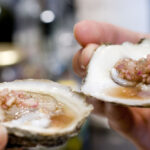
The first time I tried umeshu was at a tiny sake bar called Satsko in Manhattan’s Alphabet City, where the walls are covered in polaroids of happy, albeit slightly bleary-eyed, customers. That day, I wasn’t very happy; it was the beginning of summer and the city was hot, humid and pungent. I asked the mustached bartender for something refreshing, and he served me a whisky glass of Choya’s umeshu, on the rocks. It tasted like holidays — sweet and cold with a shiver of alcoholic oomph. It was dangerously drinkable, but I woke up the next morning feeling fresh as a daisy. I was hooked.
What exactly is umeshu?
Umeshu is often translated as “Japanese plum wine.” But it isn’t really a wine, it’s a liquor, and a rigorous, centuries-old Japanese tradition. It can only be made with green plums, ume that are picked when still unripe, and thus very sour and inedible when raw. They have a very short season — late May until June — so the window for preparation is small. The ume are steeped with rock sugar in clear, flavorless distilled spirit, typically soju. Once prepared, the liquor is left in a cool, dark place for at least three months, though a year, and sometimes even two, will yield far better results.
Just like umeshu is not actually a wine, it’s also not actually made with plums; ume are more closely related to the apricot. They were brought from China to Japan in the 6th century as an herbal medicine, and there are a myriad of health benefits attributed to umeshu because of the high levels of citric acid and antioxidants found in the fruit. It is said to soothe sore throats, improve circulation, help you recover when you are weak from heat exhaustion or sleep deprivation, and boost immunity.
These benefits have encouraged the Japanese to make umeshu at home since the 17th century, although doing so was initially only a practice for the wealthy — rock sugar was an expensive luxury. Despite the seasonal constraints and patience required, there are numerous benefits to the DIY approach. You can control the sweetness — the ratio of rock sugar:ume can vary between 1:2 and 1:1 — and the alcohol percentage — umeshu swings between 10-20% proof. Plus, the ume are edible once the umeshu is ready, and can be made into jelly or sauces. The best part is that umeshu has no expiry date, so it can be enjoyed at leisure.

Homemade umeshu is extremely difficult to find in New York, and while the Choya product I was served at Satsko was delicious — there’s a reason it’s the market leader of commercial umeshu — I wanted to delve deeper into the drink. I began by seeking out other varieties in local bars, with little success, and while there are more choices online — my current favorite is Kinmon Akita Eternal Plum Shizuku Ginsen, made with aged sake — I couldn’t shake the feeling that I was missing something.
Sipping umeshu in NYC
Turns out, I was. I’d been expecting to find umeshu as it’s drunk in Japan: a common aperitif at a kaiseki (a traditional fine dining experience that emphasizes simplicity and elegance), served on the rocks in summer and added to hot green tea in winter. But in true New York fashion, Japanese bars around the city had been adding their own twist: combining umeshu with other ingredients in cocktails.
At Katana Kitten, a Japanese cocktail bar in the West Village, bartender Masahiro Ushido subs vermouth for umeshu in a twist on the negroni, called a Meguroni (pictured at the top of this article). He explained that it’s “a great alternative… I love the plum’s aromatic flavor, but it’s also light bodied.”

Across the river at Hidden Pearl, an airy, small cocktail bar at the back of a ramen joint in Greenpoint, Brooklyn, bartender Jeremy Oertel features umeshu in a highball, fittingly called Sweet Medicine. “I remember really liking the tart plum flavor of the umeshu on top of the subtitles of the sake. I felt like it would work well in place of something like sweet vermouth and paired well with the raisiny notes from the sherry in that cocktail.” His colleague Andy May pairs umeshu with pisco and nigori (an unrefined sake) in Nigori Nights, “A tropical umami-forward cocktail.” Tokyo Record Bar, a speak easy-izakaya hybrid, combines umeshu with rose and yuzu flavors in a spritz, while Death & Co., one of New York’s most influential cocktail bars, often play with umeshu, notably pairing it with gin in a botanical take on the Martini.
This trend may not appeal to traditionalists who believe that umeshu should be sipped and savored; the addition of other spirits and sugars almost certainly cancels out any health benefits, and may not leave you feeling as fresh as I did the morning after I was introduced to umeshu. But it’s oh-so New York — fun and fresh. And who knows? Cocktails could be the next chapter in umeshu’s centuries-old story.
Satsko, 202 East 7th St., NY 10009
Katana Kitten, 531 Hudson St., NY 10014
Hidden Pearl, 621 Manhattan Ave., NY 11222

Rachel Myerson is a British-born, New York-based freelance journalist. She writes about food, culture and lifestyle for publications including Vice, Bon Appetit and Oprah Magazine.



